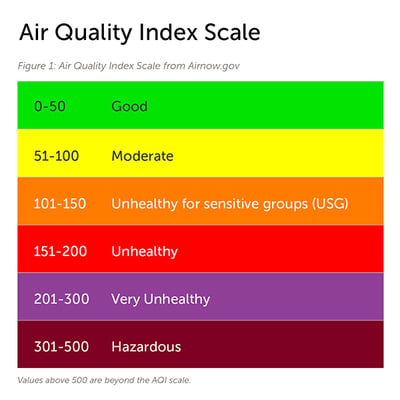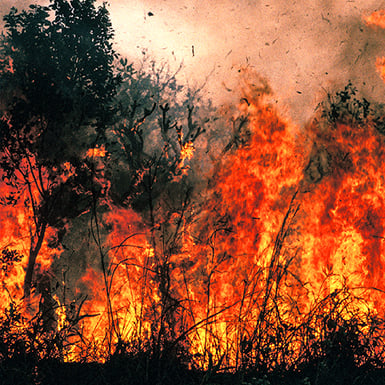Summer is the perfect season to enjoy the great outdoors with friends and family. Unless, of course, the air is filled with smoke and ash. The color-coded air quality readings too often go beyond the red danger zone into purple, with an Air Quality Index (AQI) of over 200 parts per million (ppm) of particulate contamination. This particulate count is far above what is safe even for healthy adults. In many parts of the western U.S. and beyond, purple air has become far too familiar.
 Figure 1: Air Quality Index Scale from Airnow.gov.
Figure 1: Air Quality Index Scale from Airnow.gov.
Semiconductor fabs also face air quality challenges as a result of the conditions fires present. In our continuing Tiger Yield series, let’s take a look at how the unique air quality threats can influence yield.
 Forest fires are a problem throughout the world. In March and April of 2022, fires broke out at eleven tiger reserves in India. Fortunately, no tigers died in the fires, probably because of tigers’ natural instincts to flee to safer places when fires or other dangers threaten them.
Forest fires are a problem throughout the world. In March and April of 2022, fires broke out at eleven tiger reserves in India. Fortunately, no tigers died in the fires, probably because of tigers’ natural instincts to flee to safer places when fires or other dangers threaten them.
We know that smoky air from fires is not healthy for humans and animals to breathe, but have you considered how it might affect your fab? Let’s look at what that smoke contains.
Emissions from forest fires are a very complex mix of gases and particles. The particulate matter is what we see as smoke and what the air quality reports measure. The smoke is also mixed with thousands of gas-phase contaminants, products from the combustion of biomass (e.g., trees and shrubs).
High temperature, complete combustion yields carbon dioxide, water vapor, and NOX and SOX from plant nutrients. In a real fire, however, temperatures vary, combustion is always incomplete. The result is a mix of many gaseous species. Fire smoke typically contains:
- Visible organic matter in the form of ash and burnt or burning vegetation
- Particles ranging in size from submicron to visible
- Thousands of hydrocarbon gases across the entire spectrum from methane to large molecules
- Organic gases from plant nutrients containing nitrogen, sulfur, phosphorus, halogens, and other elements
- Oxides of carbon, nitrogen, and sulfur, including CO, CO2, NO, NO2, SO2, and SO3
- Ammonia, amines, and other basic compounds
During transport, small particles and gases can significantly change through chemical reactions with the surrounding air or each other. Some react with water vapor to form acids. Particles and gases also travel hundreds of miles on air currents to regions far from the source.
All these particles and gases can enter the fab from outside. Most fabs are designed to filter incoming air. High-Efficiency Particulate Air (HEPA), and Ultra Low Particulate Air (ULPA) filters can remove particles successfully, but Minimum Efficiency Reporting Value (MERV) filters will not remove most of the particulate matter, only that above 0.3 µm.
However, none of these particle filters will remove airborne molecular contamination (AMC), for which chemical filters are needed.
What is a fab to do when forest fires threaten the health of employees and products? The answer is to think beyond HEPA and ULPA filtration systems. Chemical filters can filter and purify ambient air, which is their primary purpose. The primary purpose of AMC filters is purification. The filters remove gas phase contaminants through chemical or physical adsorption. The type of adsorbent depends on the contaminant:
- Coated carbons adsorb acids
- Ion exchangers adsorb bases
- Activated carbons adsorb organics
AMC filters are best suited to remove acids, bases, and condensable organic gases, molecules with at least six carbon atoms. Volatile organic gases are only partially removed. Fortunately, many of these are not a concern for yield.
Smoke also contains sub-µm particles that can pass through even ULPA filters. When outside air with a high concentration of sub-µm particles enters the fab, these particles can cause defects that decrease yield. Likewise, mechanical filters cannot capture the volatile and often carcinogenic gases that form airborne molecular contamination (AMC).
The best overall solution is to combine all available techniques. MERV filters and water wash systems can remove visible ash and large particles. With much of the residue already filtered out, HEPA and ULPA filters can collect micron-scale contaminants more efficiently. AMC filters then will remove gas phase contaminants.
 Figure 2: Sequence of filtration solutions to remove visible and invisible contamination from forest fires
Figure 2: Sequence of filtration solutions to remove visible and invisible contamination from forest fires
Another problem arises when external conditions overwhelm existing filtration systems. Forest fires can cause concentrations of larger particles—micron (µm) to millimeter size, including the 2.5 µm range that AQI measures—to increase to a level where particle filters become clogged well before the standard replacement interval, and the capacity of chemical filters is quickly exhausted by high AMC concentration. More frequent filter replacements may be necessary for the short term.
Smoke will challenge even the best-designed filtration system. While it is always important to monitor filter performance, it is even more so in smoky conditions. If you see it, you can control it. When efficiency drops, it is time to replace the filter. For fabs in regions prone to forest fires, keeping an eye on the forecasted AQI readings and maintaining a more extensive inventory of filters can help mitigate the effects.
Here’s to hoping your region will get through summer and fall without a major fire. Unfortunately, the risk keeps growing.
You can improve the air quality inside your fab by combining the best practices for filtration system design, maintenance, and monitoring. When you do so, the environment will be safer for workers and allow your equipment to run with the production yield you expect.
To learn more about controlling fire emissions and smoke impact, take a look.




